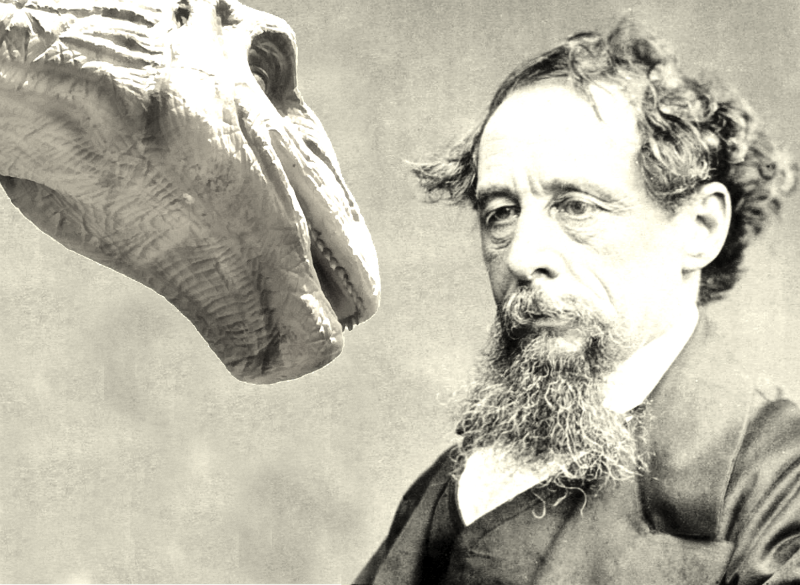
Although he is more likely remembered for coining the term “dinosaur,” Richard Owen also influenced the writings of his friend Charles Dickens. Gowan Dawson offers an historical overview of Owen, noted British anatomist and paleontologist, and suggests Dickens incorporated Owen’s paleontological analogies into his own “compositional practices” as a response to criticism of his serial novels. Dickens’s early works were often criticized for an “absence of design,” while “his most meticulously planned novels [were perceived] as potentially monstrous amalgams, joining together random and incongruous parts”.
Dickens suffered from the effects writing, publishing, and reading in installments had on narrative function and structure. Serial publication ensured an incompleteness and lack of closure, and required readers to assemble installments as sequential parts of a disconnected whole. What Dickens searched for was an adaptive model for improving upon the fragmentary form of serial fiction. As Dawson persuasively suggests, “What was necessary, in both paleontological reconstructions and the composition of serial fiction, was a flawless design that would preclude the possibility of such egregious conjunctions and instead ensure the harmony and proportion of the perfectly integrated structure”.
Dawson describes Dickens’s awareness of “his friend’s celebrated skills and accomplishments as the foremost paleontologist in Victorian Britain”. He also evaluates Dickens’s use of prehistoric images, and suggests Owen’s study and descriptions of “petrified and often only fragmentary remains evidently stimulated Dickens’s imaginative creativity”. However, Dawson does not comment on how Dickens’s paleontological curiosities might have reflected the Victorian fascination with prehistoric species. For readers unfamiliar with fossil research, Dawson might have traced briefly the early nineteenth-century roots of paleontology from the pioneering work of either Mary Anning or Gideon Mantell to Owen. In so doing, he would have provided readers with a parallel commentary on the historical and cultural influences that shaped the lives and careers of both Dickens and Owen.
Though serial publication of literary and scientific works was pervasive during the early nineteenth century, Dickens recognized “suggestive parallels between Owen’s particular mode of analyzing petrified fragments and . . . his own attempts to examine and expose the iniquitous social order that came to dominate later novels”. In the opening of Bleak House (1852-53), Dickens packed the term ‘Megalosaurus’ within a metaphor of how unpleasant weather made the streets of London more suitable for prehistoric beasts than Victorians. Similarly, in a travelogue from All the Year Round, Dickens wondered how subsequent generations might trace child poverty and neglect in the fossils of Victorian London.
Dickens juxtaposes Owen’s “integrated design” with the “underlying design of his own seemingly ill-proportioned fiction” to create a hybrid narrative. Dawson cites the metaphorical quotation from All the Year Round, but does not anticipate how the prehistoric creatures of Dickens’s earlier fiction evolved rapidly into the “serpents of smoke” and “elephant in a state of melancholy madness” fossilized among the industrialized decay found in Dickens’s Hard Times (1854).
When Dawson references Dickens’s description of “the malevolent amputee Silas Wegg . . . as resembling ‘some extinct bird’”, he does not unpack a metaphorical allusion to Dickens’s and Owen’s struggle to remain relevant, popular, and avoid career extinction. Dickens was the more successful of the two men in that regard. Owen’s notorious attempts to discredit Charles Darwin’s theory of natural selection, and his review of On the Origin of Species (1859) led to his diminution within the scientific community. Dawson later tries to deploy the previous metaphor and concludes that much like Owen, Dickens “became a kind of extinct creature to be restored to life by the careful attentions of the reader”.
Dawson reflects on Dickens’s success as a serial publisher and novelist, but he might have enriched his comments by bringing either Robert Patten’s “Publishing in Parts” or David Vincent’s “Dickens’s Reading Public” into the discussion (see Palgrave Advances in Charles Dickens Studies 2006). Patten examines the cultural and commercial significance of serial publication in the early to mid-Victorian literary marketplace, and Vincent considers the increase in public literacy and the growing popularity of “cheap literature” through serialization. Both essays might have added another layer of historical resonance to Dawson’s enjoyable article.
Through his keen insights, Dawson contributes to an already abundant field of criticism of Dickens and his work. Where Dawson distinguishes himself is in correlating close readings of Dickens’s novels with Owen’s paleontological theories and practice. In so doing, Dawson strikes a balance between literary interpretation and historico-scientific analyses to persuasively render an intriguing argument that plots the intersections of paleontological reconstruction and serial publication.
This article was originally published by the Journal of Literature and Science, where it can be read with full footnotes, under a CC-BY-NC-ND licence
The article under review, Dickens, Dinosaurs and Design, can be found at the Journal Victorian Literature and Culture [subscription required]
Rate and Review
Rate this article
Review this article
Log into OpenLearn to leave reviews and join in the conversation.
Article reviews